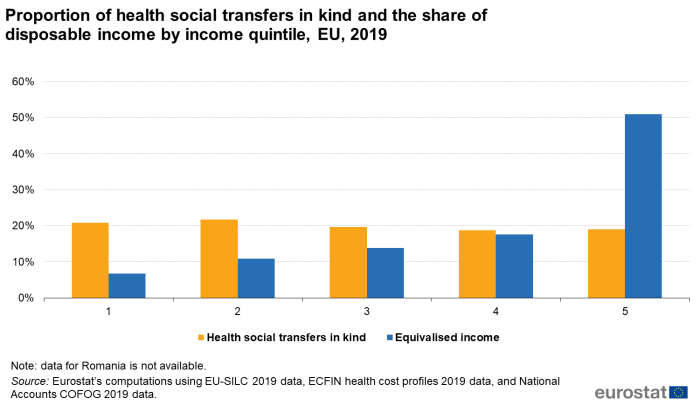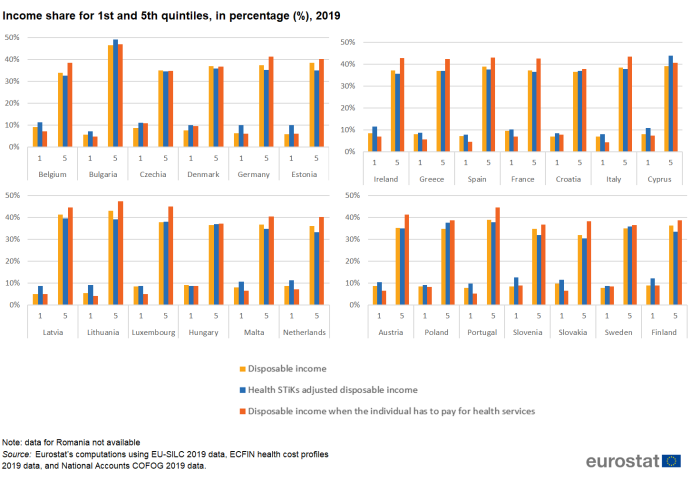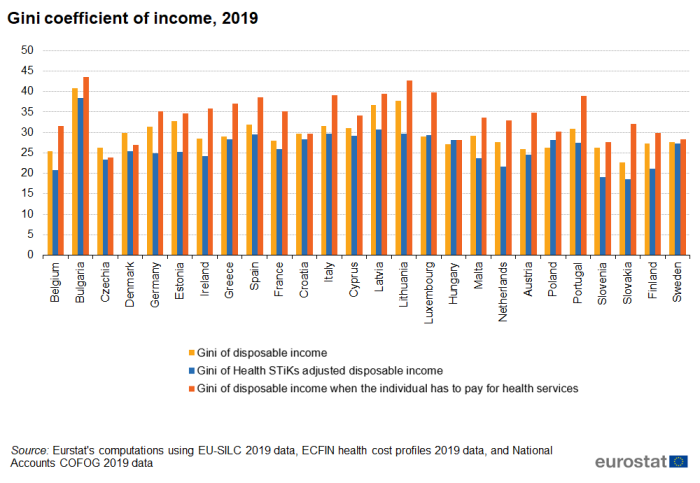Impact of health social transfers in kind on income distribution and inequality
Data extracted in October 2022
Planned article update: October 2024
Highlights
In 2019, health social transfers in kind improved the distribution of household income across quintiles in most of the EU, while their absence worsened income inequality.
Social transfers in kind (STiKs) are an important source of household income, especially for households at the lower end of the income distribution. Households receive STiK (for education, health, child care, long term care etc.) from governments or non-profit organisations to cover a wide range of services and risks. This analysis is focused on the health STiKs received by households from governments. Evidence of the effect of social transfers in kind is highly relevant for assessing material wellbeing within Europe, particularly before and during the crisis periods.
Household disposable income is the income remaining to a household after deduction of taxes which can either be spent or saved by the household. It comprises a monetary and a non-monetary component.
Monetary income indicators based on disposable income are widely used in the analysis of poverty and inequality. People are considered at risk of (monetary) poverty when their equivalised disposable income (disposable income divided by the number of household members converted into equivalised adults) - further in text referred to as disposable income - is below the at-risk-of-poverty threshold. This is set at 60 % of the national median disposable income after social transfers.
However, it does not take into account non-monetary income received. It is important to note that non-monetary income whether consumed or not, cannot be saved or transferred to another individual. Adjusted disposable income takes into account monetary (disposable) income and Social Transfers in Kind, being therefore more likely to be equally distributed than disposable income. International statistical manuals recommend using adjusted disposable income when analysing the total redistributive effect of government interventions in the form of benefits and taxes on household income.
Non-monetary indicators complement the existing monetary measures. This work explores additional aspects of inequality not covered by existing monetary indicators. With this purpose, the disposable income of the EU-SILC survey microdata has been complemented by imputing health social transfers in kind to obtain the health STiK adjusted disposable income (disposable equivalised income and social transfers in kind for health). The health care cost profiles (expenditures) by age and gender have been aligned to the government health expenditure by country provided in the National Accounts. This article studies the impact of STiKs for health on the income distribution and on other inequality measures such as the Gini index.
This article will show that the health STiKs improve the distribution of household income across quintiles, decreasing the share of income in the highest quintiles and increasing it in the lowest. In case people would need to pay the primary health expenditure out of their pocket, the inequality in the distribution of income would significantly worsen.
Full article
Impact of health STiKs on income distribution
Figure 1 shows the proportion of health STiKs and the share of equivalised disposable income by income quintile for the EU Member States (excluding Romania). The health STiKs are almost equally distributed across income quintiles, while monetary income is lowest in the first quintile and increases for each consecutive quintile.
The distribution of income is one of the main instruments to measure inequality and assess the socio-economic situation in a country.
Figure 2 shows, for each of the EU Member States (except Romania), the disposable income share distribution - for the first and fifth quintiles - distinguishing between three cases:
- The disposable income distribution;
- The health STiK adjusted disposable income distribution (disposable income and health STiKs);
- The disposable income distribution when the individuals do not receive any health STiKs and therefore have to pay these services from their own pocket.
As shown in Figure 2, the share of disposable income is lowest in the first quintile and highest in the fifth quintile for all the three cases considered. In almost all countries analysed there is a reduction in the difference between the first and last quintile of the income distribution when the population receives health social transfers in kind, indicating an increase in equality (except for Bulgaria, Cyprus, Hungary, Poland and Portugal). The largest difference between the two extremes of the income distribution is shown when the individuals do not receive any health STIKs and they have to pay the health care expenditure from their own pocket (except for Czechia and Denmark where the highest difference is shown in the disposable income case).
Results by country and by quintiles of the income distribution can also be seen in Annex I ![]() .
.
Impact of health STiKs on the Gini index
The Gini index is one of the most common indicators for income inequality. Lower value of Gini means higher equality. A Gini index equal to 0 corresponds to a perfectly equal distribution of income. For the analysis, the same three cases are considered:
- Gini coefficient of disposable income;
- Gini coefficient of health STiKs adjusted disposable income (disposable income including health STiKs);
- Gini coefficient of the disposable income distribution when the individuals do not receive any health STiKs and therefore have to pay these services from their own pocket.
Results of the three cases analysed are shown in Figure 3. Although results may vary by country, generally speaking, it can be concluded that receiving health social transfers in kind reduces inequalities in disposable income. Some countries such as Belgium, Germany, Estonia, Latvia, Lithuania, Malta, Slovenia, Slovakia and Finland experience a considerable reduction in the Gini index when people receive health STiKs. By contrast, other countries including Hungary, Poland and Sweden experience almost no changes.
Results by country of the Gini index can also be seen in Annex II ![]() .
.
Final remarks
This work has shown that social transfers in kind for health make the health STIKs adjusted disposable income (disposable and health STiKs) more equal across the income quintiles than when these social transfers are not considered and therefore, the individual has to pay out of his/her pocket the cost of health care. However, the extent varies substantially across countries (see the Excel file Annex I ![]() for country distributions).
for country distributions).
Overall, health STiKs might help to improve the distribution of household income across quintiles (for instance, in countries such as Belgium, Estonia, Lithuania and Latvia). On the contrary, the absence of public social transfers in kind would worsen the income inequality (for instance, in Luxembourg, Lithuania, Italy, Ireland, Slovakia, Greece, Spain or Austria). However, it should be noted that in some countries there are almost no variations in the distribution of income when including or excluding health care STiKs (e.g.: Hungary, Denmark, Croatia, Sweden or Poland). In almost all European countries there is a reduction in the difference between the first and last quintile of the income distribution when the population receives health social transfers in kind, indicating an increase in equality. For instance, in Slovakia, the income in the first quintile increases by 4.1 percentage points (pp) when people receive health social transfers in kind, and by 3.6pp in Latvia. By contrast, when individuals have to pay the cost of health services out of their own pockets, the income decreases in the first quintile by 3.46pp in Luxembourg, and by 3.3pp in Slovakia.
Regarding the Gini index for the health STIKs adjusted disposable income (disposable income and health STiKs), it could be concluded that the inclusion of health STiKs reduces inequalities. In some countries such as Belgium, Denmark, Germany, Estonia, Ireland, Latvia, Lithuania, Malta, the Netherlands, Slovenia, Slovakia and Finland, the Gini index for the health STIKs adjusted disposable income is considerably lower than for disposable income (for instance, in Lithuania the GINI index decreases by 7.9pp and by 7.5pp in Estonia). However, when people have to pay the cost of health care out of their own pockets, the GINI index rises in most of the countries, with the largest increases in Luxembourg (by 10.7pp) and Slovakia (by 9.5pp). By contrast, other countries such as Croatia or Sweden experience almost no changes. The experimental nature of this analysis and the assumptions made when using the results derived from this study should be noted.
Feedback
To help Eurostat improve these experimental statistics, users and researchers are kindly invited to give us their feedback by email
Source data for tables and graphs
Data sources
Methodological considerations
Households receive social transfers in kind (STiKs) from government or non-profit organisations serving households (such as churches). This work focuses on health STiKs (services and means) received by households from government with a series of assumptions:
- Public benefits: STiKs services are assumed to be uniform at country level, meaning that some social security standards are not taken into account;
- Valuation of health STiKs: the estimation of health STiKs is made following an insurance approach (please see the Methodological note for a complete definition);
- Adapted equivalence scale for social transfers in kind (namely, the NET-SILC2 equivalence scale): Disposable income and STiKs services’ value is allocated at household and individual level using an adapted equivalence scale for social transfers in kind. This particular equivalence scale was developed by the NET-SILC2 network which can be understood as a re-modelled modified OECD equivalence scale that takes into account STiKs (more information about this equivalence scale can be seen in the Methodological note section).
Different data sources have been used in this work to construct a database. The disposable income data is complemented by imputing social transfers in kind into survey microdata (EU-SILC). The health care cost (benefits) profiles by age and gender have been aligned to the government health expenditure by country provided in the National Accounts.
For a detailed explanation of the methodology followed in this work, please see the dedicated Methodological note.
Note concerning the Gini index results
Note that, due to the NET-SILC2 equivalence scale used in this study, the results shown in this work differ slightly from the Gini coefficient of disposable income - EU-SILC survey (ilc_di12) published by Eurostat based on the modified OECD equivalence scale.
Context
This work explores additional aspects of inequality not covered by existing monetary indicators. With this purpose, the disposable income of the EU-SILC survey microdata has been complemented by imputing health social transfers in kind to obtain the health STiK adjusted disposable income distribution (disposable equivalised income and social transfers in kind for health). The health care cost profiles (expenditures) by age and gender have been aligned to the government health expenditure by country provided in the National Accounts. This article studies the impact the Social Transfers in Kind (STiKs) for health have on the adjusted disposable income distribution and on other inequality measures such as the Gini index.
Direct access to
Dedicated section
Methodology


